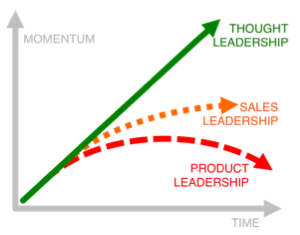3 go-to-market strategies: only one winner
August 29, 2012

If you’re a technology company with a high-value B2B offering that requires an on-going direct sales interaction with your prospects, you have three go-to-market strategy options. At certain stages in your evolution, they might all appear to be equally effective - but it’s hard to implement them all equally well.
So if your ambition is to lead your market (and if not, why are you in business?), you have to choose - and to execute your chosen option brilliantly. And it turns out that one of these go-to-market strategies performs head-and-shoulders above the rest when it comes to achieving clear and sustainable market leadership.
Product Leadership
Most technology companies naturally default to a product leadership strategy, and many never escape from it. They seek to develop product offerings that they position as having a radically new or superior feature set - and a product leadership strategy can appear at first to be highly effective when selling to early adopters in new markets.
But sooner or later, product leadership erodes. Competitors copy core features - and even if you are protected by patents, they will find a way around sooner or later. Later stage buyers tend to be less concerned about specific features or functions - and your development team finds it progressively harder to develop their way out of these lack-of-differentiation problems.
Sales Leadership
The second go-to-market option is to go for sales leadership, and to build a highly-driven sales team that is simply better at “hand-to-hand combat” than the opposition. Armed with superior product/industry knowledge and professional sales skills, they stand out in competitive sales cycles, and can be highly effective in mid-stage markets.
But sales leadership is hard to sustain. It’s an inherently high-cost operating model, and it gets progressively harder to recruit and ramp-up enough “A” class sales players to maintain the momentum - and as a colleague once remarked, “eagles don’t flock”. At some point, these deal-driven companies just find it too hard to keep all the plates spinning quarter after quarter.
Thought Leadership
 The third option is to thought-lead a clearly and often narrowly-defined market (see “is your target market small enough?”) through a superior vision that enables you to identify, attract, engage, qualify and convert more of the right sort of prospects and to develop a pipeline of opportunities that are predisposed to buy.
The third option is to thought-lead a clearly and often narrowly-defined market (see “is your target market small enough?”) through a superior vision that enables you to identify, attract, engage, qualify and convert more of the right sort of prospects and to develop a pipeline of opportunities that are predisposed to buy.
Organisations with a thought leadership strategy are able - unlike most of their competitors - to consistently stand out from the crowd by standing for something. They generate a great deal of inbound interest, and are able to strongly influence the prospect’s buying agenda and put competitors on the defensive.
They do not have to rely on feature-function lists or superior hand-to-hand sales combat skills to win business - because they have managed to shape their prospects perceptions of what they need and who they need it from. And in a world where, according to research from the CEB, 57% of the buying process is typically complete before the prospect invites the vendor to the party, thought-leading companies start with what is often an unchallengeable advantage.
What’s your approach?
Perhaps you’ve been reflecting on your own go-to-market strategy. Which of the above models does it most closely reflect? And what could you do to emerge as the thought leader in your market?
Have you clearly defined your market? Does it really represent a common set of similar existing and potential customers, with a similar set of critical issues that could be satisfied by a similar set of solutions? And do they reference each other when making buying decisions? If not, you have no market to lead.
Are you able to identify the common characteristics of your most valuable prospects? Do you truly understand the impact to them of not addressing the issues you have chosen to address? Does your approach set you apart from the crowd? Are you choosing to convey why and how you are different before trying to claim that you are better?
Do your sales and marketing processes truly reflect how your customers make buying decisions? Do you understand the barriers that might delay or derail their decision - and have you put programmes in place to eliminate them? Are you regarded by your prospects as the most valuable and least risky of all the options open to them, including sticking with the status quo?
If not, you have work to do. But if you can master these disciplines, you’ll emerge in the best possible position to thought-lead your markets.
Executive Workshop in London
By the way, this article was inspired by one of my most influential mentors, Richard Currier, now at InterSystems and once described as "the go to guy for fixing revenue growth in Silicon Valley". I'll be contributing to his executive workshop in London on 20th September for UK-based CEOs and Sales and Marketing Directors of growth-phase B2B technology companies. We’ll be developing many of the themes from this article. You can find out more here.


Comments